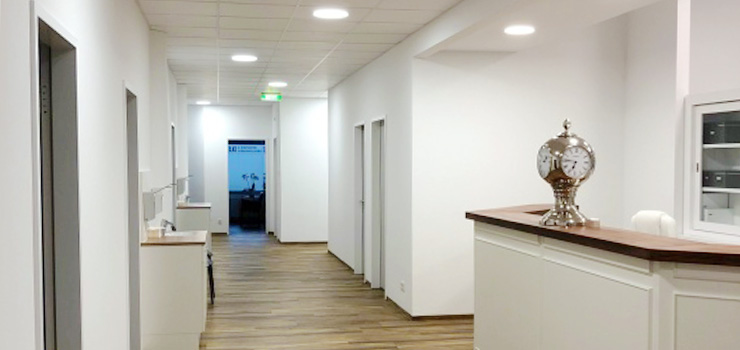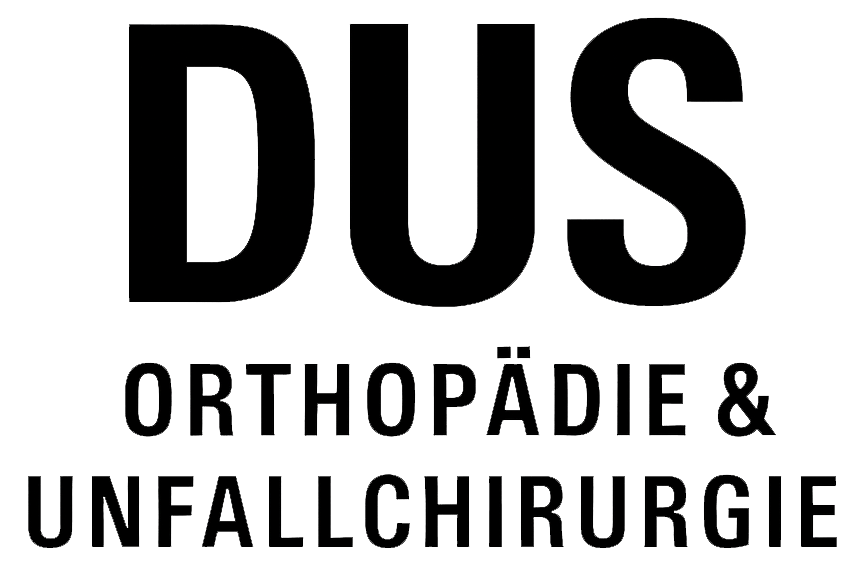Endoprosthetics in Düsseldorf
Do you suffer from joint wear and tear on your knee, ankle or hip, or have you suffered an injury to your joint in an accident? Endoprosthetics can be useful so that you no longer feel pain and your freedom of movement is preserved.
But what is an endoprosthesis? This is an artificial joint that can replace your broken or worn knee or hip joint. Endoprosthetics can also help with damaged ankle joints – for example due to arthrosis. The main cause for the insertion of a knee or hip prosthesis is age-related wear and tear of the joints. Find out more about arthroplasty in our practices at DUS Orthopaedics & Trauma Surgery here.
Advantages | Procedure | FAQ | Locations
Advantages of an endoprosthesis
The insertion of hip or knee prostheses is a routine procedure in Germany. Hip arthroplasty in particular is performed comparatively frequently. An artificial joint can help you to move again without pain, so that you no longer suffer from restricted movement.
The methods for inserting knee and hip prostheses are now particularly gentle. Depending on the findings, arthroplasty can even be performed in a minimally invasive way. This protects the tissue and muscles and healing after the operation is usually faster.
Thanks to modern technology, the endoprostheses are also becoming more and more robust, so that even moderate sport can be possible again after the operation. Whether competitive sports are also possible for you after the insertion of a hip arthroplasty or knee prosthesis must be decided individually. We will be happy to advise you on this.
Endoprosthetics can partially or even completely replace your joint. Partial dentures are rarely used, however, as complete dentures are more beneficial for your later mobility. The joint replacement is made of lightweight and well-tolerated materials. Prostheses made of metal alloys, polymers or even ceramics are conceivable. Which one you can use depends on various factors – for example, allergies to certain substances. The variety of arthroplasties is an advantage, as it makes it easy to find the right joint for you.
Procedure of the treatment
Endoprosthetics involves replacing your broken or worn joint with an artificial prosthesis. During the operation, the artificial joint is either anchored or cemented into the surrounding bone. This depends on how intact the bone is and whether osteoporosis is present.
In a minimally invasive procedure on the hip, a direct anterior approach is made to the joint. This method allows the hip joint to be replaced without cutting muscle tissue. Also on the knee, only a comparatively small skin incision is necessary to replace the joint.
Expertise
At DUS Orthopaedics & Trauma Surgery, you benefit from a large, well-trained team of specialists in the field of joint treatments. Knee or hip arthroplasty is one of our most frequently performed treatments. In our practices in Düsseldorf and Ratingen, we provide you with holistic treatment from the initial examination and consultation to the operation and aftercare.
Anwendungsbereiche
Endoprostheses can now be used on various joints. Such arthroplasty is most often performed on the knee or hip, but it can also be used for the ankle or shoulder joint. Endoprostheses for elbow and finger joints are used less frequently, but depending on the findings, this is also conceivable.
Risks
The operation to replace a joint usually takes place under a general anaesthetic. Such an operation is therefore always associated with certain risks due to the anaesthesia. The insertion of an endoprosthesis is a moderately difficult operation. You will be informed about this individually before the treatment.
In addition, the anchoring in the bone can very rarely cause bone tissue to be blown off. In these cases, additional fixation by wire or screws becomes necessary. After a few years, the implant can also become loose. There is little risk of this happening, but it can lead to the replacement of the hip or knee prosthesis under certain circumstances.
After surgery, swelling and bruising around the treated joints are more common. These symptoms are normal and usually disappear within a few days.
Before the surgery
Before arthroplasty is performed on the knee, hip or ankle, a detailed medical history is taken and a thorough examination is carried out. Before an implant is used, it must be ensured that no other therapy works. If the cartilage degradation is not yet so far advanced, a cartilage transplant can already achieve good results.
Before the operation, you will be informed about the prospects of success of arthroplasty. In addition, we will check which prosthesis is suitable for you. Depending on the findings and medical history, thrombosis prophylaxis may be useful.
Duration
Normally, the replacement of a joint takes about 1- 11/2 hours. As the insertion of an endoprosthesis is a moderately difficult operation, you should plan for an inpatient stay.
When you can start physiotherapy treatment depends on various factors. This includes, for example, the type of implant, the material of the endoprosthesis and also the joint itself. With cemented prostheses, light mobilisation of the joint can begin the day after the operation. Physiotherapy after surgery is usually prescribed for at least three months. The duration and cycle of physiotherapy is determined individually.
After the operation
After the operation, the wound healing process begins, which can be supported by painkillers. Depending on the arthroplasty, light mobilisation of the treated joint can begin after just a few days. This should usually be done carefully and under supervision so as not to overstress the new joint. The implant needs a certain amount of time to grow firmly into the bone. Therefore, subsequent physiotherapy is also necessary. This ensures that you learn how to load the endoprosthesis in the knee or hip correctly and move it moderately. Until it is fully healed, physiotherapy is a good way to mobilise the joint properly and help you heal.
FAQ
What types of endoprostheses are there?
There are different prostheses for joints at the knee or hip. An arthroplasty can be a surface replacement, a partial replacement or a complete implant. Depending on which prosthetics are used, the operation and the material of the knee or hip prosthesis also varies.
What types of hip surgery are there?
How expensive is arthroplasty?
We offer this service for you
at the following locations:

Location D-Grafenberg

Location D-Stockum

Location D-Oberkassel Heerdt


